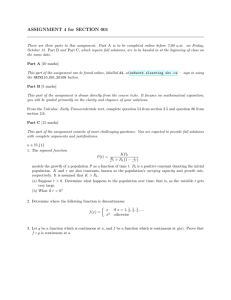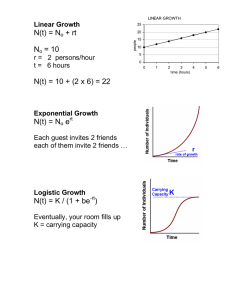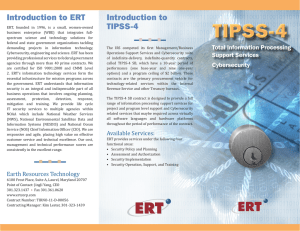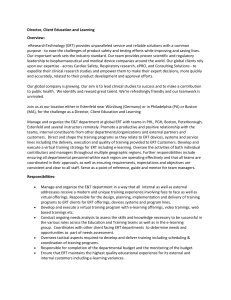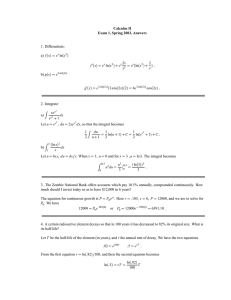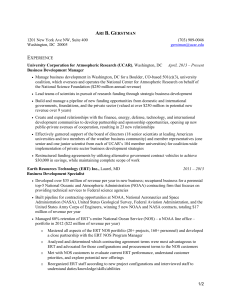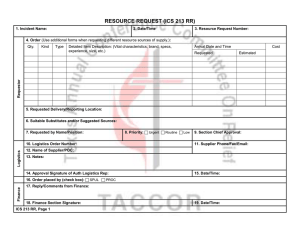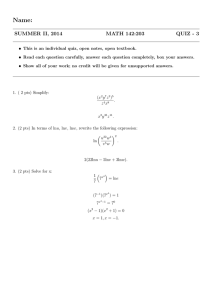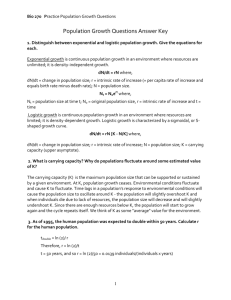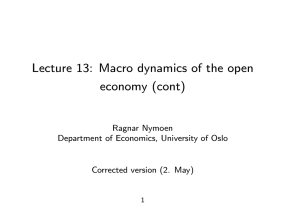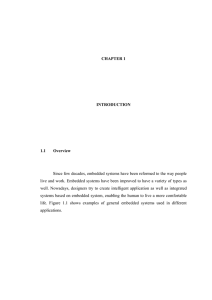Chapter 3: Modelling and Applications
advertisement
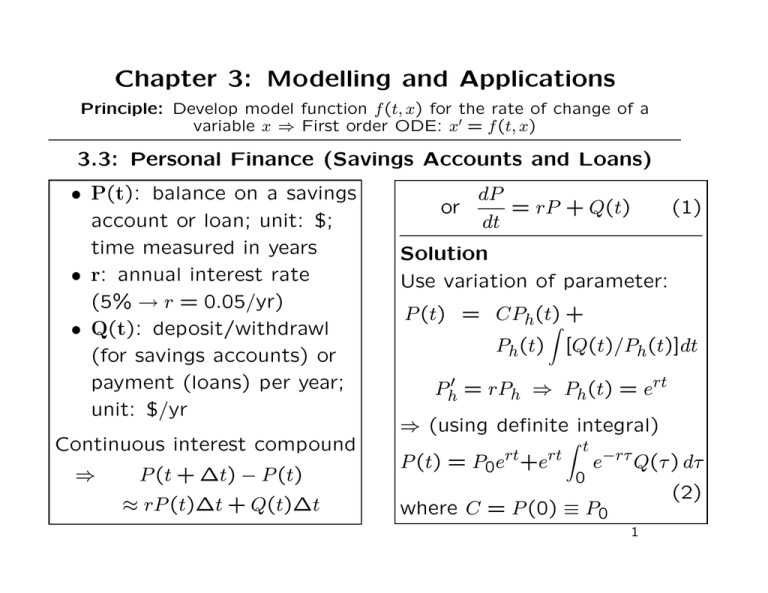
Chapter 3: Modelling and Applications Principle: Develop model function f (t, x) for the rate of change of a variable x ⇒ First order ODE: x′ = f (t, x) 3.3: Personal Finance (Savings Accounts and Loans) • P(t): balance on a savings account or loan; unit: $; time measured in years • r: annual interest rate (5% → r = 0.05/yr) • Q(t): deposit/withdrawl (for savings accounts) or payment (loans) per year; unit: $/yr Continuous interest compound ⇒ P (t + ∆t) − P (t) ≈ rP (t)∆t + Q(t)∆t dP or = rP + Q(t) dt (1) Solution Use variation of parameter: P (t) = CPh(t) + Z Ph(t) [Q(t)/Ph (t)]dt Ph′ = rPh ⇒ Ph(t) = ert ⇒ (using definite integral) P (t) = P0ert+ert Z t 0 e−rτ Q(τ ) dτ (2) where C = P (0) ≡ P0 1 P (t) = ert(P0 + Q0/r) − Q0/r If Q(t) = Q0 = const : Savings accounts: ( Q0 = D > 0 if deposit Q0 = −W < 0 if withdrawl Loans: Q0 = −W < 0; (3) ) W : yearly payment Examples for (3) Example 3.4 Savings account without deposit/withdrawl: P (t) = P0 ert Assume P0 = $ 1000, r = 0.05. After 40 years: P (40) = 1000 e0.05×40 = 1000 e2 = $ 7389 Ex. 4: Investment in education. Assume P0 = 0, r = 0.0625 (6.25 %). Goal: P (18) = $ 50, 000. Q: What is D ? P (t) = (D/r)(ert − 1) → solve P (18) = (D/r)(e18r − 1) = 50, 000 for D ⇒ D = (50, 000 × 0.0625)/(e0.0625×18 − 1) = $ 1502.25 2 Ex. 6: (Loan). Assume r = 0.08, term = 4 yrs, monthly payment $ 225 ⇒ W = $ 12 × 225/yr = $ 2700/yr. Question: Amount P0 of loan? Solution: P (t) = ert(P0 − W/r) + W/r Solve P (4) = e4r (P0 − W/r) + W/r = 0 for P0 ⇒ P0 = (W/r)(1 − e−4r ) = (2700/0.08)(1 − e−4×0.08 ) = $ 9, 242.45 Example 3.9 Saving for retirement. Assume Savings account with P0 = 0, r = 0.05 and annual deposit D = $ 2000. Q: retirement start up money P (30) = ? Solution: P (t) = (D/r)(ert − 1) After 30 years: P (30) = (2000/0.05)(e0.05×30 − 1) = $ 139, 267.6 (not much!) Example 3.11 Computing start up money needed for retirement. Given r = 0.05, annual withdrawl W = $ 50, 000/yr, find P0 s.t. P (30) = 0. Solution: P (t) = ert(P0 − W/r) + W/r Solve P (30) = e30r (P0 − W/r) + W/r = 0 for P0 ⇒ P0 = (W/r)(1 − e−30r ) = (50, 000/0.05)(1 − e−30×0.05 ) = 106(1 − e−1.5 ) = $ 770, 896.8 3 Example for (2) Example 3.12 Saving for retirement start up money needed. Model: • S(t): annual salary, S0: initial salary, q: annual salary increase rate ⇒ S ′ = qS ⇒ S(t) = S0eqt • ρ: fraction of annual salary deposited ⇒ annual deposit: D(t) = ρS(t) = ρS0 eqt • r: interest rate on savings account, P0: initial deposit. Use Eq. (2) with Q(t) = D(t) ⇒ Z t Z t e−rτ D(τ )dτ = P0ert + ρS0ert e−rτ eqτ dτ P (t) = P0 ert + ert 0 Z t 0 = P0 ert + ρS0ert e(q−r)τ dτ = P0ert + ρS0 ert[1/(r − q)](1 − e(q−r)t ) 0 rt = P0 e + [ρS0/(r − q)](ert − eqt) (if q 6= r) Assume P0 = 0. Given P ∗ and t = h, determine ρ such that P (h) = P ∗ ⇒ [ρS0/(r − q)](erh − eqh) = P ∗ ⇒ ρ = (r − q)P∗ /[S0(erh − eqh)] Number Example: r = 0.05, q = 0.04, h = 40 yrs, P ∗ = $ 1, 600, 000, S0 = $ 35, 000 ⇒ ρ = 0.01 × 1, 600, 000/[35, 000(e40×0.05 − e40×0.04 )] = (16/35)[1/(e2 − e1.6 )] = 0.19 = 19 % Hint for Ex. 10: Use D(t) = 1000 + 500 t 4
